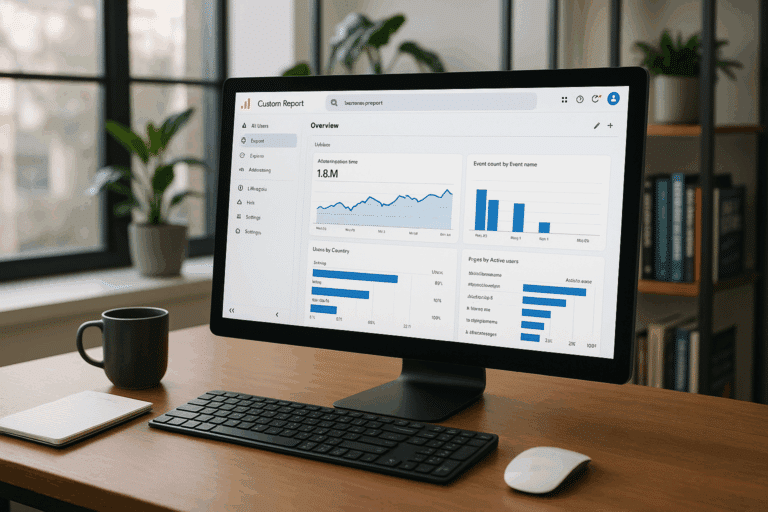Traffic is flowing, conversion rates are climbing, but there’s a nagging question at the back of your mind – “Who exactly are these people interacting with my brand?” It’s a question that can leave many marketers scratching their heads. Thankfully, there’s a tool that can help with that: Google Analytics 4 (GA4). 🧩
When it comes to audience insights, GA4 is a power-packed tool that’s transforming the landscape of data-driven marketing. However, navigating through its advanced features and complex interface can feel like you’re trying to decode an alien language. 👽 But don’t fret! This comprehensive guide is designed to demystify GA4’s audience segments, ensuring you can harness the full potential of this tool for your targeted marketing success.
One of the core features of GA4, and the focal point of this blog, is the audience segment. This feature offers a granular understanding of who your users are, what they are doing, and how they are interacting with your brand across various touchpoints. Understanding these segments can supercharge your marketing strategies, and help you achieve a laser-sharp focus on your target audience. 🎯
The key to unlocking the true power of GA4’s audience segments lies in understanding its nitty-gritty details and knowing how to utilize them in your marketing endeavors. From crafting personalized campaigns to making informed decisions, these insights offer a wealth of opportunities to drive marketing success. And that’s exactly what we’re going to explore in this blog.
Over the course of this article, we’ll delve into the various aspects of GA4’s audience segments, including:
- Understanding the basics of GA4’s audience segments: We’ll strip down to the basics and explain what audience segments are and why they’re crucial to your marketing success.
- How to create and manage audience segments in GA4: A step-by-step guide to help you navigate the process of creating and managing your audience segments. 📊
- Exploring the applications of audience segments: We’ll show you how to apply these segments to your marketing campaigns and the potential benefits you can reap.
- Advanced tips and best practices: These nuggets of wisdom will help you get the most out of GA4’s audience segments for targeted marketing success.
This blog is for you if you’re a marketer, a business owner, or anyone interested in leveraging the power of GA4’s audience segments. So, buckle up and prepare for a deep dive into the world of GA4 and its audience segments. Let’s take your targeted marketing strategies to the next level! 🚀
Before we plunge into the details, a quick reminder: digital marketing, like any other field, is all about constant learning and adaptation. Tools and platforms, including GA4, evolve and grow. Stay open-minded, keep experimenting, and remember – every piece of data is a stepping stone to your marketing success. 💡
Now, let’s unravel the mysteries of GA4’s audience segments together!
Unleashing the Power of GA4’s Audience Segments
Delving into the deep sea of audience insights, GA4’s audience segmentation has emerged as a powerful tool that marketers can leverage to drive targeted marketing success. The new generation Google Analytics, GA4, is designed to offer marketers a more comprehensive view of their audience. It effectively unifies data across various user devices and interaction platforms, thus offering a complete user journey insight. For those who are yet to harness its full potential, this article will help demystify GA4’s audience segments. 🧐
Before moving forward, ensure you watch the video, “Google Analytics 4 (GA4) – Complete Beginners Guide” by Measureschool. It provides a comprehensive overview of GA4, helping marketers, especially beginners, understand the platform better.
Understanding GA4’s Audience Segmentation
GA4’s audience segmentation works in a unique way. Instead of simply focusing on what users are doing on your website or app, GA4 considers why they are behaving in a particular way. By offering a holistic view of user behavior, it helps marketers create more personalized and effective marketing strategies. 🎯
The following table provides a comparison between GA3 and GA4 audience segmentation capabilities.
| Feature | GA3 | GA4 |
| User Interaction Tracking | Limited to user activities on your website or app | Unifies data across various user devices and interaction platforms |
| Personalized Audience Segments | General audience segments | Highly personalized audience segments based on a wide array of user data |
| Machine Learning | Limited machine learning capabilities | Advanced machine learning capabilities to predict user behavior |
Advantages of GA4’s Audience Segmentation for Targeted Marketing Success
Targeted marketing is the key to success in this age of digital advertising. 🚀 Here’s how GA4’s audience segmentation can help you achieve your marketing goals.
Enhanced User Understanding
By providing a holistic view of your users, GA4 helps you understand them better. This enables you to create more personalized and effective marketing strategies. For instance, you can identify the most profitable customer segments and focus your marketing efforts on them.
Advanced Prediction Capabilities
GA4’s advanced machine learning capabilities allow it to predict future user behavior. This can be invaluable in planning your marketing strategies. For instance, you can predict which users are likely to make a purchase in the future and target them specifically.
Improved ROI
By targeting the most profitable customer segments, you can maximize your return on investment (ROI). GA4’s audience segmentation allows you to achieve this by enabling you to focus your marketing resources on the most promising prospects.
To gain a deeper understanding of how GA4’s audience segmentation can improve your marketing ROI, watch the video “Maximize ROI with GA4” by Google Analytics.
Getting Started with GA4’s Audience Segmentation
Now that we have discussed the why, let’s move on to the how. How can you leverage GA4’s audience segmentation to drive targeted marketing success? Let’s break it down into a few easy steps. 📝
- Step 1: Start by defining your audience. This involves identifying the characteristics of your ideal customer. These can include demographics, interests, behavior, and more.
- Step 2: Once you have defined your audience, use GA4’s tools to segment them. You can create custom segments based on your audience definition.
- Step 3: Analyze your audience segments. Look for patterns and trends that can inform your marketing strategies. For instance, you might find that a particular segment is more likely to make a purchase than others.
- Step 4: Use your findings to inform your marketing strategies. Target your most promising prospects with personalized messages and offers.
- Step 5: Continually monitor and adjust your segments. As your business and audience evolve, so should your segments. Keep an eye on your analytics to identify any changes and adjust your segments accordingly.
Remember, the key to successful audience segmentation is to continually monitor and adjust your segments. So keep an eye on your analytics, and don’t be afraid to tweak your segments as needed. 🎯
By leveraging GA4’s audience segmentation, you can unlock valuable insights into your audience, drive targeted marketing success, and maximize your ROI. So start harnessing its power today and take your marketing strategies to the next level. 🚀

Conclusion
In this article, we have discussed the fundamental principles of software engineering, its importance, and how its methodologies can drastically improve the workflow of any software development project. The key highlights we have delved into include: Software Development Life Cycle (SDLC), Agile methodology, DevOps approach, and the critical role of quality assurance in the success of a software product. 👨💻
Understanding the Software Development Life Cycle (SDLC) is the backbone of any software development project. It is a process that consists of a detailed plan describing how to develop, maintain, and replace a specific software system. We stressed the significance of each phase of the SDLC – Planning, Analysis, Design, Development & Testing, Deployment, and Maintenance, which when implemented carefully, can lead to a high-quality software that meets customer expectations. 📚
We further explored the Agile methodology, which offers a flexible approach to software development. It allows for changes in project requirements as it progresses, with a focus on customer satisfaction through continuous delivery. Agile methodology ensures that the most valuable features of a product are produced and delivered first. 🚀
Another significant aspect we discussed was the DevOps approach, which brings together the Development and Operations team to enhance collaboration and productivity. This approach ensures continuous integration, continuous delivery, and quicker software releases, leading to higher efficiency and better-quality products. 💼
Quality Assurance (QA) plays a pivotal role in software development. It focuses on preventing defects in a product and ensuring its quality. The role of QA is to monitor the software engineering processes to ensure quality. It not only saves the cost of fixing bugs but also helps in delivering a product that meets the client’s expectations.🔍
To sum it up, understanding these software engineering principles can greatly improve the efficiency and effectiveness of your software development projects. It not only results in a high-quality product but also ensures customer satisfaction, making it a win-win situation for both the clients and the developers. 💯
I would like to encourage you, dear readers, to comment below with your experiences in applying these software engineering principles. Have you found them effective in improving your software development processes? Also, feel free to share this article within your network to help others learn these beneficial concepts. 🙏
Let’s continue the conversation and spread the knowledge. Remember, every time you share an article, you’re contributing to a global community of knowledge, and that’s something truly remarkable. 👏
For further reading, I recommend checking out some of the following sources: [Insert active links]. You can also explore other articles on our website that delve into the various aspects of software engineering and its methodologies.
References
[Insert active reference links]
Conclusion
Software engineering is a field that is constantly evolving, with new methodologies and technologies coming up. It’s crucial to stay updated and adapt these best practices to stay ahead in this competitive industry. Implementing these software engineering principles in your development process will not only lead to a successful project but also a satisfied customer. Remember, quality should never be compromised, and continuous learning is the key to improvement. 🎯



